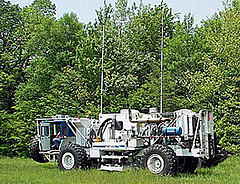Jan. 19 webinar to look at seismic testing with Marcellus gas play
live.psu.edu/story/57147#nw69
Thursday, January 12, 2012
UNIVERSITY PARK, Pa. — A Web-based seminar sponsored by Penn State Extension will examine seismic testing associated with Marcellus gas development in Pennsylvania.
Titled “Seismic Testing: What’s It All About?”, the 75-minute webinar will begin at 1 p.m. on Jan. 19. Presenters will be Kenneth Hall, of Kenneth Hall Consulting Services of Snow Shoe, Pa., and Dennis Langlois, of Houston, Appalachian region sales and marketing manager for CGG Veritas.
Hall is a retired financial adviser who has been involved in natural-gas leasing and investment for more than 15 years. He manages more than 30,000 acres of gas rights in northern Centre County and has negotiated gas leases on more than 40,000 acres.
Langlois has been in the seismic business for 32 years, the past 24 years with CGG Veritas Land Surveys. He started working on field crews in an entry-level position and worked his way up to his current job.
During the Jan. 19 webinar, Hall will discuss the potential problems that may be encountered with seismic testing and conditions property owners should require prior to approving the testing.
“Attaching conditions to the approval will minimize any potential conflicts,” he said, noting that he has been assisting property owners and mineral owners with their conflicts for many years.
“I have seen seismic testing from all sides: surface owners who do not own their mineral rights, leaseholders, gas companies and seismic companies. My experience with the potential conflicts of each party gives me unique insight into seismic-testing issues.”
Langlois will offer a slide presentation, giving a brief summary of events that take place in acquiring a 3-D seismic survey, from the initial contact with the landowners until his company has acquired the data and left the area.
“The slide presentation will show maps with surface abstracts and the recording grid needed to image the subsurface,” he said. “There also will be pictures showing the different operations and the equipment that will be used to acquire this data.”
Langlois hopes webinar participants will ask questions about the process because he is hoping to dispel misconceptions and clarify misinformation about seismic-testing operations.
The webinar is part of a monthly series of online workshops addressing opportunities and challenges related to the state’s Marcellus Shale gas boom. Information about how to register for the session is available on the webinar page of Penn State Extension’s natural-gas website.
< http://extension.psu.edu/naturalgas/webinars >
Future webinars will focus on transportation patterns and impacts from Marcellus development, and municipalities’ roles related to water use and protection.
Previous webinars, publications and information also are available on the Penn State Extension natural-gas website, < http://extension.psu.edu/naturalgas > covering topics such as air pollution from gas development; the gas boom’s effect on landfills; water use and quality; zoning; gas-leasing considerations for landowners; implications for local communities; gas pipelines and right-of-way issues; legal issues surrounding gas development; and the impact of Marcellus gas development on forestland.
For more information, contact John Turack, extension educator based in Westmoreland County, at 724-837-1402 or by email at jdt15@psu.edu.
Ohio Mayor Buys Quake Insurance as He Seeks Answers on Fracking
www.businessweek.com/news/2012-01-05/ohio-mayor-buys-quake-insurance-as-he-seeks-answers-on-fracking.html
January 05, 2012
By Mark Niquette
The mayor of Youngstown, Ohio, says he wonders whether a well used to dispose of wastewater from oil and natural-gas drilling is making his city shake. Just to be safe, he’s bought earthquake insurance.
“You lose your whole house, that’s your life savings, and if you have no money or no insurance to replace it, then what do you do?” Mayor Charles P. Sammarone said in a telephone interview today. “Information is needed to make the homeowner and the residents feel safe.”
There have been 11 earthquakes in this northeastern Ohio city since D&L Energy Inc. began injecting drilling brine, a byproduct of hydraulic fracturing, 9,200 feet (2,804 meters) underground in December 2010. The strongest, magnitude 4.0, hit last week on New Year’s Eve.
Sammarone said he has asked the City Council to pass a resolution tonight supporting state Representative Robert F. Hagan, a city Democrat who has called for a moratorium on so- called fracking and injection-well activity “until we can conclude it’s safe.”
Republican Governor John Kasich and the Ohio Department of Natural Resources consider the earthquakes isolated occurrences that are being addressed, said Rob Nichols, a gubernatorial spokesman. Injections will continue at the other 177 such wells without interrupting shale-gas development that may produce thousands of jobs, he said.
“We are not going to stand by and let someone drive a stake through the heart of what could be an economic revival in Eastern Ohio,” Nichols said yesterday in a telephone interview.
Brick House
The Natural Resources Department said the company agreed to stop operations at the Youngstown well Dec. 30 after data showed the earthquakes were occurring nearby at the depth of the injections. After the Dec. 31 quake, the state ordered work suspended and put on hold proposals for four other wells within a five-mile radius pending further study, Nichols said.
Sammarone said he hopes state officials will give the city more information next week. He decided to buy a policy on his one-story brick house after the Dec. 31 quake because before March, there was no recorded seismic activity in the city.
“About 3 o’clock, there was a loud bang that lasted, I don’t know, a couple seconds, and then all of sudden, the house started shaking and stuff fell off the wall,” he said. “It seemed like it lasted forever, but it was probably eight, 10 seconds. But it was very scary because we’re not used to that.”
“Two days later, on Monday, I called my insurance man and got earthquake insurance.”

